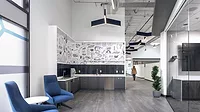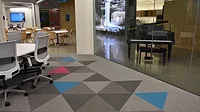The Need for Innovation in Commercial Flooring

In 2018 senior partners from McKinsey & Company, a global management consulting firm, published “Strategy Beyond the Hockey Stick: People, Probabilities, and Big Moves to Beat the Odds.” The authors discovered that over a 10-year period, just one in 12 companies managed to jump from the middle tier of corporate performance―where 60% of companies reside, making very little economic profit―to the top quintile where 90% of global economic profit is made. They propose to dramatically improve performance, you must overcome incrementalism.
One could take the position that innovation can be revolutionary or evolutionary (incrementalism). Incrementalism is just the sort of challenge we face in the commercial flooring industry. Incrementalism, lack of revolutionary innovation, anchors our relative positions at the middle (construction & engineering) or low end of the business power curve (building products) compared to software at the very top end of the curve. While so many industries continue to push forward with true innovation, our industry linking commercial building products with construction continues to struggle with incrementalism and lack of innovation. Innovation can be related to product, process, or business model. It cannot be accomplished by siloed functions, and in our industry, it does not take place in some laboratory.
In February 2018, the World Economic Forum and The Boston Consulting Group jointly published a multi-year study on global construction. They shared that while most industries have undergone tremendous changes over the past few decades, and have reaped the benefits, the North American construction sector (including commercial flooring) productivity has stagnated over the past 50 years. They attributed this mediocre result to various internal and external challenges such as persistent fragmentation of the industry, poorly executed collaboration between the players, difficulty in adopting technology, difficulty in recruiting a future-ready workforce, and limited knowledge transfer from project to project to embed standard operating procedures.
Despite indictments by the global intelligentsia, our industry has a profound impact on all other businesses, enabling them to thrive. The commercial flooring industry is part of the infrastructure and improves the quality of built assets. We are included in the center of the global economy and directly impact the lives of every person. We need to improve the speed of incremental innovation to defend our value proposition and catch up with technologically savvy and timeless industries, such as agriculture and mining. This will improve our financial performance and value delivered, allowing us to compete for the best clients and most talented associates in the marketplace.
Based on feedback from the Starnet membership and observations from years in the industry, some suggested areas of innovation focus could move our industry forward quickly.
Because more than half the value of commercial flooring is derived from the effort of the commercial contractor field teams, that area of the business is primed for innovation driven value. Some would be skeptical of the impact due to subcontracted labor and endless variations of jobsites and schedules. Innovations that other industries have already built can be deployed by our industry. The fast food industry, automotive industries, and agricultural industries have deployed numerous standard operating procedures (SOP) to skilled and unskilled workers in various chaotic environments, including outdoors.
All of these SOP’s that can be modeled by contractors to increase productivity and operational excellence. Nearly every part of a commercial installation could be systemized as a repeatable process under any schedule and site conditions. There would still be limited hand skill effort that requires a craftsman’s technique, but they should only be on the job to deploy that skill at the correct time. The removal from a pallet and opening of a bag of patch could be trained as a repeatable process for optimal safety, yield, and minimal effort. The sports industry models human effort for optimal performance using film and post-game coaching sessions. They have been doing this since early in the last century.
The best innovations come from the broad deployment of standards and technology tools at the action level, not the management level.
Why not leverage techniques from sports to optimize the “free agent” performers in our industry, the subcontracted installer? Additionally, the teams in the field have numerous technology tools that can be used to better communicate, record site conditions, document jobsite progress or lack of, and the impact of other trades on their productivity and safety. The best innovations come from the broad deployment of standards and technology tools at the action level, not the management level. In addition, properly motivated action level teams innovate to produce more output with better quality if the tools for making the progress and recording the results are in their hands. Does the iPhone come to mind or a high speed (and strangely quiet) remote controlled grinding machine? These innovations and process improvements are also more attractive and inspirational to early career workers, which are shocked by the archaic daily activity of our industry in the field.
Another area primed for innovation is commercial pricing strategy and execution. The disruption of the last few years exposed massive disconnects in the communication of pricing at the action level in the field against fixed price contracts over time. The massive loss of profit and productivity due to this disconnect between the way commercial real estate works (in square foot or square meter carpet leaders, not square yard) and the stakeholder discussion on pricing burdened by the unavoidable bid process. This disconnect even impacted the design community, which was embarrassing for the industry. As a designer would you prefer to allocate budget to an orderly and predictably priced finish, or throw money at the Wild West? This has not been corrected and will not be corrected until an innovative company leads the industry to a solution. What we do know is that price volatility and lack of visibility to forecast any price—let alone the proper price for a time period—was devastating to many in commercial flooring. The innovative solution remains ahead of us, and it may have already been solved by the airline industry or the oil field services industry. Their innovations could be deployed by our stakeholders.
The last area that comes to mind is product innovation, but most people expect it here. Unfortunately, this is another area where our industry has lagged, but the challenge is profound. The reality is that true product innovation in our industry will be held back by building codes, outdated industry association standards (allowing the worst performer to set the bar to get consensus), and the ‘or equal’ bid process to kneecap the innovators for their effort. Fashion has been substituted for innovation, but we are grateful to have it.
There are some great opportunities for innovation in product to increase the productivity in the field. The packaging, labeling, and installation recommendations of most products available leave significant room for improvements to win the gratitude of contractors and end users. Those areas are primarily focused on meeting the needs of the pick/pack/ship processes of the manufacturer and protecting the very delicate products during shipping. Normal citizens would be astonished at the amount of time, energy and manpower wasted handling packing materials on a jobsite. Manufacturers should be working hard to determine what is needed in packaging to reduce the waste and allow contractor field teams to work efficiently. The industry also needs to continue to work on “deliver and assemble” flooring products using less adhesive/spray adhesive/no adhesive that perform in the commercial environment. This commercial performance expectation needs to be supported by a LESS Limited Manufacturer’s Warranty that acknowledges that high heels, heavy desks and cabinets, rolling loads, and wheeled office chairs are in every work environment. The commercial flooring needs to be able to deal with it as a normal standard of performance, not a warranty limitation.
The progress of the commercial flooring industry depends on the same human effort and technological capabilities that drive success in all industries. These include collaboration, digitization, harnessing data, harnessing artificial intelligence (AI), developing requisite human skills, and cross-functional teams and agile ways of working. We have a few of these in hand. Let’s pick up the pace and ‘Partner For Success’ so we can get on to AI and harnessing data like the leaders of the business power curve.
Looking for a reprint of this article?
From high-res PDFs to custom plaques, order your copy today!






